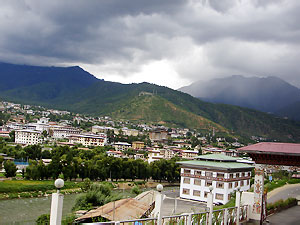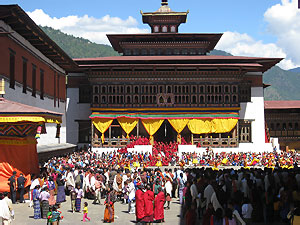|
|
Thimphu, Bhutan |
|
General Information about Thimphu
Latitude: 27ºN
Longitude: 89ºE
Population: 30,340 (1993)
Language: Dzongkha
Religion: Mahayana Buddhism
Information about Thimphu
Since 1960, the capital of Bhutan is Thimphu. Thimphu is
situated at a height of over 7600 feet on a hillside in
a fertile valley on the banks of the Thimphu Chhu River.
Thimphu is perhaps the smallest capital in the world.
The town of Thimphu is nothing like what a capital city
is imagined to be. |
 |
|
|
One
interesting fact about this city is that it is the only world
capital without any traffic lights. Thimphu is a gallery of
traditional Bhutanese art, architecture, culture, and
tradition and above all still so ethnic and pure. It is a
fitting and lively place. The wooden houses stand side by side
with concrete buildings, all painted and constructed in
traditional Bhutanese styles. For most part of its history,
Bhutan has tried consciously to save its culture from the
blunt influences of the western world. It is not that
modernity has not reached this region, but they are being
introduced in a phased and balanced manner that is unheard of
at any place in the world. All these make Thimphu and other
parts of the country a unique destination.
History of Thimphu
Not much is known about the history of Bhutan because of its
long seclusion from rest of the world. New explorations have
suggested about the presence of men around this region in 2000
BC, but written history dates back to 2nd century AD. Buddhism
as the supreme religion and a way of life was introduced in
Bhutan in 8th century when Indian Buddhist monk Padmasambhava
(Guru Rimpoche) came to Bhutan and established many
monasteries. The Drukpa sub - sect of Kagyud school of Mahayan
Buddhism was established as orthodoxy by scholar Padmalingpa
in the 15th-16th century. The rise of Drukpa sect also led to
establishment of the theocracy of Druk - yul by Shabdrung
Ngawang Namgyal in 1616. Shabdrung is considered as the person
who unified the country and constructed most of the remarkable
temple - fortresses known as dzongs. He also started the dual
system of spiritual and temporal leaders that was ended by Sir
Ugyen Wangchuk in the late 19th century. Sir Ugyen Wangchuk
became the first hereditary king of the country and its first
reference to modernity. Jigme Dorji Wangchuck, father of the
present king, is considered as the "father of modern Bhutan"
since most of the developments that led the country towards
modernity started during his reign. The present king Jigme
Singye Wangchuck became the fourth monarch in 1974 and his
coronation ceremony saw the entry of foreign media for the
first time in the country. The first foreign tourist group
entered the country very next year and started the process of
restricted entry of tourists to save the culture and
environment. |
|
|
|
Festivals of Thimphu
Most of the festivals (Tsechus) in Thimphu have some or
other connection with Buddhism. These festivals are
celebrated in the Dzongs with dances, music, and
religious allegorical plays. Some of the important
festivals include Bhutanese New Year in January or
February, Buddha Parinirvana and Birthday of Guru
Padmasambhava in May or June, first sermon of Buddha and
Yar Nyidlok in June or July, Blessed Rainy Day, Thimphu
Domchey, and Nine Evils Day.
Accommodation in Thimphu |
 |
|
|
Not many hotels are there in Thimphu as in
other capital cities of the world, but accommodation certainly
is not a problem. With the smaller number of tourists being
allowed to visit, there is not much of an accommodation
crisis, except in the high season. Most of the hotels are good
and operate with all the modern facilities. Constructed in the
traditional Bhutanese style these hotels provide you the
experience of living in an ethnic village. The accommodation
in Thimphu is available in Hotel Motithang. Hotel Motithang is
built in the classical Bhutanese style at a height of 2560
meters above sea-level on 20 acres of land. It played host to
various heads of states and governments on the occasion of the
coronation of His Majesty, King Jigme Singye Wangchuck.
Shopping in Thimphu
Thimphu offers a wide range of products to the tourists to
take back home as souvenirs. The shops in Thimphu sells tea,
horseshoes, cooking oil and cloth fabrics. The Handicrafts
Emporium displays a wide variety of hand woven and crafted
products like papier-mache masks, prayer wheels, decorative
motifs, silk-screened handmade paper, rings and ornaments, and
woven wool or silk clothes, precious stones and postage stamps
(available at the General Post Office).
Adventure in Thimphu
Entire region around Thimphu has excellent trekking routes of
different levels giving you ample opportunities for hiking,
trekking, river rafting, and wildlife excursions.
Tourist Attractions in Thimphu
The various tourist attractions in Thimphu are Tashicho Dzong,
Simtokha Dzong and Stupa. Tashicho Dzong, the main secretariat
building, houses the main government departments, all the
Ministries, the National Assembly Hall, the office of the King
and the Throne Room and summer headquarters of the Central
Monastic Body. It is also the summer residence of the monk
body and the religious chief, the Je Khempo. The Simtokha
Dzong is the oldest Dzong in Thimphu and gateway to the
Thimphu Valley. This dzong still enjoys the strategic
importance as it did in 1627. The Dzong houses Rigney School
for Dzongkha and monastic studies. The stupa-styled monument
is also situated in Thimphu.
More....
How to reach Thimphu
By Air
The nearest airport in Bhutan is Paro.
By Road
From Bagdogra in India, it is possible to travel for about 175
km by road to Phuentsholing, the entry point in Bhutan. From
Phuentsholing there is a tiring 179 km journey to Thimphu
although the journey gives you a great chance to appreciate
the natural beauty of the country. It is also possible to
travel to Phuentsholing from Siliguri and Kolkata. Thimphu can
be easily reached from Paro, Punakha and Trongsa. |
|